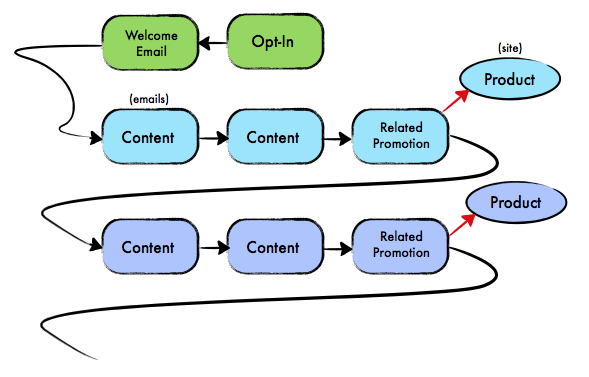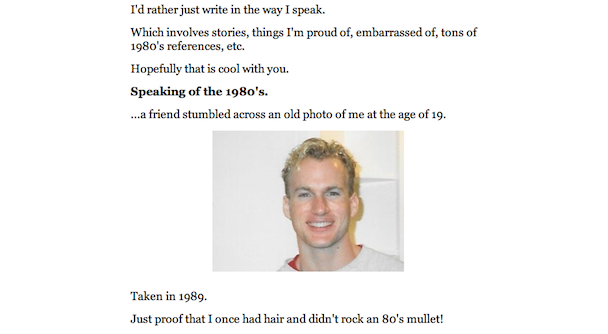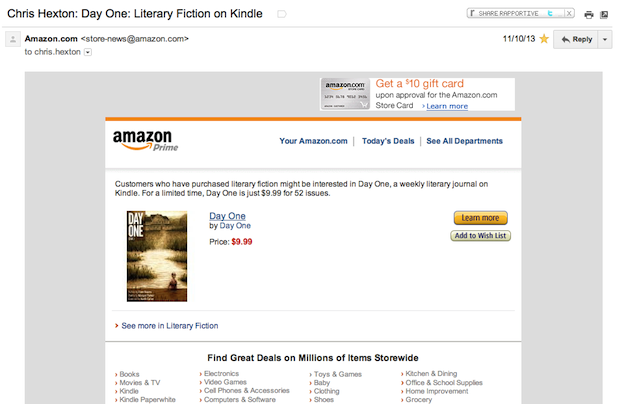Frustrating, isn’t it?
You poured countless hours into coming up with the perfect email series, loading it in your email software, and dripping it out to your subscribers.
But where’s the engagement?
Where are the sales and customers?
For many businesses, automated email marketing doesn’t live up to the hype. It isn’t for a lack of effort. Marketers in a variety of niches grasp the concept, but they struggle with the execution. There’s a common pattern of mistakes that trip them up.
Discovering what those mistakes are is the first step to avoiding them and getting more out of your email autoresponder. Keep reading to find out how.
 Photo Credit: Death to the Stock Photo
Photo Credit: Death to the Stock Photo
Overlooking a Solid Foundation for the Details
Savvy marketers use email autoresponders to free up time, make sales, and automate much of their online lead generation and nurturing process. But many more struggle to put them into action.
When things don’t go well, most marketers are focusing on the wrong things. Maybe they Google the “best” times to send emails and tweak their autoresponder. Or they change their delivery schedule after finding out a guru recommends messaging only certain days of the week.
Issues like email frequency and timing do affect the effectiveness of autoresponder sequences. But for most marketers who are struggling, this is missing the forest for the trees.
Details matter, but it’s counterproductive to get caught up with them without a proper foundation in place—a foundation that creates engagement, builds trust, and drives sales.
Are You Making Any of These Key Email Autoresponder Mistakes?
So, how can you put that foundation in place and make your email autoresponders more profitable?
It starts by avoiding the following key mistakes a lot of online marketers are making. Just not doing these things pulls you ahead of 99% of the competition. It puts you in the perfect position to worry about details and “tweak” your email campaigns—after they’re built on solid ground.
So let’s dive in. Here are five critical email autoresponder mistakes businesses make (and how to avoid them):
5. Choosing the Wrong Topic
If you choose the wrong topic (or no topic) for your autoresponder series, not even all the optimization and testing in the world can save you.
A lot of businesses get excited about the potential of email autoresponders and dive in without giving this much thought. They crank out content and start sending… only to be left scratching their heads when no one opens their emails.
The best email sequences fulfill users’ informational needs. Your target customers will devour your emails—even if you send them frequently—as long as they’re engaging and relevant.
How can you figure out what’s relevant before investing weeks into creating an autoresponder series? There’s no need to figure it out all on your own. You can turn to your current customers and email subscribers to point you in the right direction.
The most straightforward option: ask your subscribers and customers directly. You can reach out via phone, email, or online surveys. Focus on their pain points. What are they struggling with the most right now? Those are great “seeds” for an engaging email series.
You can also turn to social media, forums, and Q+A sites like Quora in your niche. Which topics are getting the most traction? What are the emotional “hot buttons?” Check out what your successful competitors cover in their content—and the reaction it’s getting. There are an incredible number of tools available (a ton of them are free) that can help you with this type of competitive “content” research.
If you a have a company blog, focus on your most popular content. Which articles got the most enthusiastic response? Something as small as a blog comment can inspire an idea for your entire email series.
4. Struggling to Create Enough Content
Email subscribers join your list because they’re curious to find out more. How long it takes to turn curiosity into readiness to buy depends on the individual subscriber. Some will buy after a few emails, but others need months or years to become buyers.
So it makes sense to expand your autoresponder series as long as possible, giving yourself the opportunity to capture even the most reluctant customers. But it can be challenging to come up with ideas for new content and find the time to create it.
A time-efficient way to fill out your autoresponder series is to recycle content you’ve already created. If you’ve had a blog for a while, most new subscribers won’t go through your old posts. So why not direct their attention to some of your best posts in your email series? You can repurpose content and arrange it into a series based on a common theme. Then you can deliver it to subscribers in bite-sized chunks.
Chopping up longer reports and eBooks into a batch of emails is another option. These resources might be overwhelming to most people in “long form.” But you might be surprised how much engagement you get if you’re willing to slice them into smaller pieces and drip them out over email.
Podcasts and videos are also great “recyclable” content you can use to connect with subscribers. And if you’ve given presentations or hosted webinars, you can link subscribers to slidedecks or transcripts of the most valuable parts.
3. Pitching Too Aggressively (and Too Often)
It takes a lot of work—getting the right traffic to your website and enticing them with a compelling lead magnet—to get someone on your email list. So it can be tempting to push hard for the sale right away.
A lot of marketers get into trouble pushing too early and aggressively for the sale. That’s the ultimate goal of course, but going at it too strongly puts off a lot of subscribers. It comes off as transparent; you’re just trying to make some quick cash.
Once you get someone on your list, resist the temptation to hard sell right away. A good guideline to follow: offer value most of the time with an occasional offer mixed in.
John Fancher, who helps marketing expert Perry Marshall with his autoresponders, recommends an “80/20 rule” of offering value and pitching:
The method we teach is 80% content / 20% pitch. Rather than pitching in every message, we recommend making deposits first… for 3 or 4 messages of pure, helpful content.
Pat Flynn from Smart Passive Income illustrated his “bait and hook” autoresponder method that helps him make six figures monthly:

Image credit: Smart Passive Income
The optimal frequency of value to pitch depends on what you’re selling and your subscribers. You can experiment and track the results to find what works best for you. But start with a strong foundation: 1) don’t push too hard for the sale early on, and 2) offer a lot of valuable content interspersed with occasional offers.
2. Boring Subscribers with Their Delivery
Even with a relevant topic and valuable content, some businesses struggle to get subscribers to read and engage with their emails.
The problem isn’t the material they’re sending, but how they’re delivering it. Busy subscribers won’t take the time to unravel boring, confusing business emails. Not with their inboxes stuffed to the brim.
It’s worth putting some attention into your email delivery. Connecting with subscribers on a personal level sets you apart from the mountains of unremarkable emails they receive every day.
Valuable content is necessary, but not sufficient for success. Wrapping it up in an entertaining package makes people far more likely to read it.
In the words of email marketing expert Ben Settle:
Email is talk radio.
Your subscribers want valuable content, but they also want to be entertained. So don’t be afraid to let your personality shine. Just like viral blog content, connecting with someone’s emotions is one of the best ways to get them engaged. It’s okay to be playful every now and then too.
Rusty Moore, an online fitness marketer, delivers a great mixture of value and entertainment in his daily emails. Here’s part of an email he sent selling a fat-loss supplement:

Email is an intimate way to connect with prospects. So it makes sense that an intimate conversation would work well to get people interested and keep them reading. Avoid “corporate speak” at all costs!
1. Overlooking Trigger-Based Autoresponder Emails
Autoresponders can “drip” a series of emails out to a subscriber over designated time intervals. That’s a useful way to create consistent touch points with your prospects and build relationships over time. But limiting yourself to using autoresponders this way exclusively leaves you missing out on their full potential.
Enter “trigger-based” autoresponder emails. In this application of autoresponders, your prospects’ behavior determines 1) which emails are sent and 2) when to send them.
This sounds more complicated than it is, so let’s illustrate the concept with an example. Ever browsed Amazon and had something like this show up in your email inbox a few days later?

Image credit: Vero
Amazon just sent you a trigger-based automated email. Your actions on their website (in this case, purchasing literary fiction for Kindle), set the process in motion and determined the content of the email.
Trigger-based emails like these have much higher open rates and engagement than emails dripped out over designated time intervals. Chris Hexton of Vero explains it well:
Newsletters have an open rate around 20%, and transactional emails have an open rate around 50%. This means that trigger-based transactional emails are over 100% more effective than newsletters. The fact is that emails based on customer actions get more opens, clicks, and conversions because they are contextual.
A lot of marketers struggle because the timing of the emails they send doesn’t sync up with their subscribers’ interest at that moment. Using a combination of timed and trigger-based autoresponder emails can help you give them the context they need to open, engage, and eventually buy.
Building a Solid Foundation to Supercharge Your Conversions
With the right foundation in place, email autoresponders are one of your most useful tools to connect with prospects, build trust, and make sales automatically.
Building that foundation doesn’t have to be overwhelming. Just by paying attention to things your competitors overlook, you can avoid crucial autoresponder mistakes that make you want to pull your hair out.
Then you can dial in the details like timing, frequency, and split-testing subject lines to take your autoresponder series from good to great. You’ll save time and deliver content your prospects love. Win win.
Do you use an email autoresponder? How has it affected your business? Share your story below in the comments!






